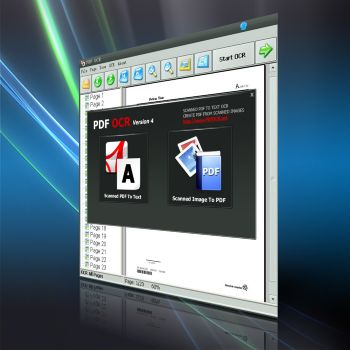
- #OCR & PDF CREATION SOFTWARE INCLUDED HOW TO#
- #OCR & PDF CREATION SOFTWARE INCLUDED INSTALL#
- #OCR & PDF CREATION SOFTWARE INCLUDED PORTABLE#
- #OCR & PDF CREATION SOFTWARE INCLUDED CODE#
- #OCR & PDF CREATION SOFTWARE INCLUDED SERIES#
Tesseract_data_dir: Path = Path( "/home/joris/Downloads/tessdata-master/") Try it out # New imports from pathlib import Pathįrom _as_optional_content_group import OCRAsOptionalContentGroupįrom _text_extraction import SimpleTextExtractionĭef apply_ocr_to_document(): # Set up everything for OCR Now, let's apply OCR to this document, and overlay actual text so that it becomes parsable:ĭata Visualization in Python, a course for beginner to intermediate Python developers, will guide you through simple data manipulation with Pandas, cover core plotting libraries. The rest is an Image with text (the Image you created): When you select the text in this document, you'll see immediately that only the top line is actually text. The resulting document should look like this: # Write with open( "output_001.pdf", "wb") as pdf_file_handle: # Main method to create the document def create_document(): # Create Document # New imports from .image.image import Imageįrom .page_layout.multi_column_layout import SingleColumnLayoutįrom .page_layout.page_layout import PageLayoutįrom .text.paragraph import Paragraph Now let's build a PDF with this image, to represent our scanned document, that isn't parsable, as it doesn't contain metadata: import typing # Create ImageFont # CAUTION: you may need to adjust the path to your particular font directoryįont = uetype( "/usr/share/fonts/truetype/ubuntu/UbuntuMono-B.ttf", 24) Creating an Image import typingįrom PIL import Image as PILImage # Type: ignore from PIL import ImageDraw, ImageFontĭef create_image() -> PILImage: # Create new Image This Image will then be inserted in a PDF. You'll start by creating a method that builds a PIL Image with some text in it. With the content now restored, the usual tricks ( SimpleTextExtraction) yield the expected results. Once finished, the recognized text is re-inserted in each Page as a special "layer" (in PDF this is called an "optional content group"). If you'd like to read more about OCR in Python, read our Guide to Simple Optical Character Recognition with PyTesseract! This class uses tesseract (or rather pytesseract) to perform OCR (optical character recognition) on the Document. In this section we'll be using a special EventListener implementation called OCRAsOptionalContentGroup. borb, however, loves to help and can be applied in these cases, with built-in support for OCR. And most PDF libraries will not be able to handle them. They contain all the meta-data needed to constitute a PDF, but their pages are just large (often low-quality) images, created by scanning physical papers.Īs a consequence, there are no text-rendering instructions in these documents. Most of the documents for which this doesn't work are PDF documents that are essentially glorified images. The answer is often as straightforward as "your scanner hates you".
#OCR & PDF CREATION SOFTWARE INCLUDED CODE#
"Your text-extraction code sample does not work for my document. "My document does not seem to have text in it. This is by far one of the most classic questions on any programming-forum, or helpdesk:
#OCR & PDF CREATION SOFTWARE INCLUDED INSTALL#
Installing borbīorb can be downloaded from source on GitHub, or installed via pip: $ pip install borb “My PDF Document Has No Text!”
#OCR & PDF CREATION SOFTWARE INCLUDED HOW TO#
In this guide, we'll take a look at how to apply Optical Character Recognition (OCR) on a scanned PDF document.



It offers both a low-level model (allowing you access to the exact coordinates and layout if you choose to use those) and a high-level model (where you can delegate the precise calculations of margins, positions, etc to a layout manager). In this guide, we'll be using borb - a Python library dedicated to reading, manipulating and generating PDF documents. In fact, PDF is based on a scripting language - PostScript, which was the first device-independent Page Description Language.
#OCR & PDF CREATION SOFTWARE INCLUDED SERIES#
To achieve this, PDF was constructed to be interacted with via something more like a programming language, and relies on a series of instructions and operations to achieve a result. It was developed to be platform-agnostic, independent of the underlying operating system and rendering engines.
#OCR & PDF CREATION SOFTWARE INCLUDED PORTABLE#
The Portable Document Format (PDF) is not a WYSIWYG (What You See is What You Get) format.


 0 kommentar(er)
0 kommentar(er)
